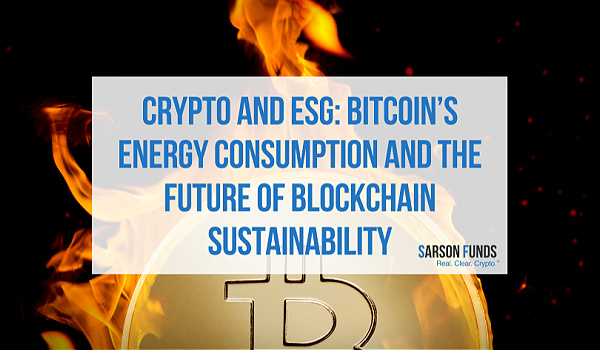Liam McDonald
With critics questioning the viability of the crypto ecosystem after sustainability concerns raised by Elon Musk and others, Sarson Funds believes that crypto moves in stride with the future of sustainable finance and ESG investing. Contrary to popular opinion that Bitcoin and crypto assets are encouraging ill-spend of the global energy supply, this article will overview Bitcoin’s true energy usage next to traditional financial institutions, highlight the primary energy source of Bitcoin mining operations, and identify how the ecosystem is launching more scalable, energy efficient blockchains to spearhead the future of financial operations.
To begin, let’s consider the computations of Sarson Funds Chief Marketing Officer Jahon Jamali, who recently calculated the true energy usage of the entire traditional banking system next to Bitcoin’s singular decentralized network. Jamali derived this number by adding together 3 metrics: server, branch, and ATM costs, which he estimated to be an average of 140 terrawat-hours (TWh) per year to power its operations, while Bitcoin uses only 32.56 TWh per year. While 32.56 TWh beats the energy usage of the entire country of Norway, comparing these vastly different entities is like comparing apples and oranges. To measure Bitcoin’s energy usage in relation to a more comparable entity, it is only fair to size Bitcoin up against the system it is competing against: the global financial infrastructure. Traditional finance uses roughly 400% the energy that Bitcoin does, so while the Bitcoin network does use a substantial amount of energy, it pales in comparison to the system it aims to upend.
The next argument to tackle: Bitcoin and dirty energy. This past week, Bitcoin lost nearly 12% of its value when Elon Musk raised concerns that much of Bitcoin’s mining and transaction operations were sourced from fossil fuels. Musk commented on his concern for cryptocurrency’s adoption coming with environmental costs in a tweet this past Wednesday, stating “Cryptocurrency is a good idea on many levels and we believe it has a promising future, but this cannot come at great cost to the environment.” While Musk’s concerns are valid regarding the use of dirty energy in some crypto mining, 76% of Bitcoin miners are using renewable energy to fuel their operations, according to Ark Investments in a recent CNBC “Closing Bell” interview. So, while Bitcoin may be using comparable amounts of energy as Norway, its carbon footprint is somewhere between half and a quarter, according to a Coinshares article on the environmental impact of Bitcoin mining.
Lastly, several blockchains have emerged in the past year that aim to construct a new horizon of sustainability for the crypto ecosystem. These blockchains have integrated Proof-of-Stake (PoS) block creation protocols, the sustainability-minded progression from Proof-of-Work (PoW) block validation, also known as mining, that powers the aggressive energy consumption of industry leaders like Bitcoin, Ethereum, and Litecoin. PoS protocols allow token holders with certain native token reserves to stake tokens, meaning that their own token holding allows them to validate blocks on the network and collect token rewards over time. Instead of miners using large quantities of energy to solve mathematical functions and unlock a block, Proof of Stake protocols randomly select one token staker to validate the next block and collect staking rewards, similar to how miners collect mining rewards. PoS protocols create competition among stakers by encouraging larger token holdings in order to increase the chances of a staker being selected as the next validator. Current industry leaders in PoS protocols are Ethereum, Polkadot, Cardano, Algorand, and CasperLabs. Large scale adoption of staking protocols will substantially relieve the crypto ecosystem from the environmental concerns related to the mining process, creating a pathway for crypto to be embraced on a global scale.
With these recent advancements, the crypto ecosystem is strengthening the longevity of the global financial system in an increasingly environmentally focused landscape. Crypto’s focus on energy efficient scalability is naturally building the blueprint for a sustainable financial future.







